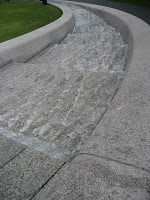The British Museum
3 Comments
»

August 17th & 24th
I have lived across the street from the British Museum for a solid 2 and a half months and except for a brief peek inside on the 4th of July, this was the first time I actually visited it. Terrible, right? Especially since I was a History major. But when something is so close it’s easy to put off visiting it. It would have been utterly disgraceful to leave London and not see it, however, so finally I ventured inside.
The museum is so big and sprawling I actually went on two separate weekends. The first Sunday I entered without a clue where to go or even what I was supposed to see. I dimly recalled something about facades from the Parthenon, but I had no idea where to find them in the vast museum. In fact the first room I wandered into turned out to be the gift shop. Hmmm. Once through the gift shop I did come across a cavernous room holding actual artifacts, including a massive stone foot from a toppled Roman statue. But no bits of the Parthenon were to be seen. I wandered across the wondrously dizzying Great Court – the heart of the museum, which has the most spectacular ceiling I’ve ever seen – and at last found my way to the Egyptian & Greek & Roman statues.
I have lived across the street from the British Museum for a solid 2 and a half months and except for a brief peek inside on the 4th of July, this was the first time I actually visited it. Terrible, right? Especially since I was a History major. But when something is so close it’s easy to put off visiting it. It would have been utterly disgraceful to leave London and not see it, however, so finally I ventured inside.
The museum is so big and sprawling I actually went on two separate weekends. The first Sunday I entered without a clue where to go or even what I was supposed to see. I dimly recalled something about facades from the Parthenon, but I had no idea where to find them in the vast museum. In fact the first room I wandered into turned out to be the gift shop. Hmmm. Once through the gift shop I did come across a cavernous room holding actual artifacts, including a massive stone foot from a toppled Roman statue. But no bits of the Parthenon were to be seen. I wandered across the wondrously dizzying Great Court – the heart of the museum, which has the most spectacular ceiling I’ve ever seen – and at last found my way to the Egyptian & Greek & Roman statues.

Right away I came upon the Rosetta Stone, which was quite exciting, as you can imagine. It’s encased in glass, of course, so my photo mostly shows the reflection of all the people standing around instead of the writing. But the writing really is incredible to see in person – each of the three languages is written in teeny letters but quite clear all the same. I don’t think I knew before that the Rosetta Stone was a black stone, with the etched letters showing up white. Thus far it’s the most striking ancient artifact I’ve ever seen.



After a bit more confused meandering through galleries that completely upended my sense of direction, I finally found the Elgin Marbles, the statues and friezes taken from the Parthenon by Lord Elgin in 1801. They’ve been displayed at the British Museum ever since 1816. The friezes run down both walls of a long gallery, with the statues from the pediments at either end. Nearly all the statues are missing heads and occasionally arms, but the friezes are in remarkably good condition. My favorite sections featured large troupes of men on horseback – the detail was extraordinary, and I really got the sense of energy and movement even out of figures frozen in stone. I spent the rest of my time studying the friezes until the museum closed.






The next Sunday I returned to the museum – I’d only seen those few areas on the first floor, and I knew there was a great deal more to see. So I promptly got lost in the endless galleries again. Not that I was ever really lost, but I definitely had no sense of direction. But it’s nice to wander around a museum with no sense of purpose, to explore leisurely and pop into random rooms that strike your fancy. I ambled my way through galleries devoted to China, India, Japan, ancient Egypt (complete with real mummies!), Celtic Britain, and even twentieth-century American graphics artists. I loved looking at the sleek ink drawings of 1920s New York, with women in cloche hats walking beneath towering skyscrapers.

I was at the deepest end of the Celtic Britain galleries looking at a massive iron cauldron when they announced closing, and as I made my way out I was surprised to find I was on the opposite end of the museum than I’d thought. I spent two days there and I’m sure I still didn’t see everything.






































 Subscribe by RSS
Subscribe by RSS